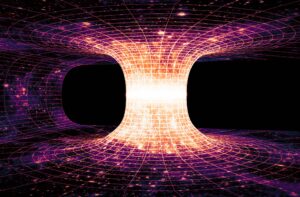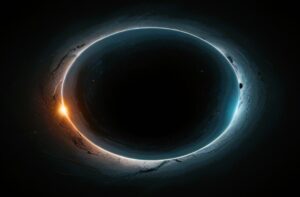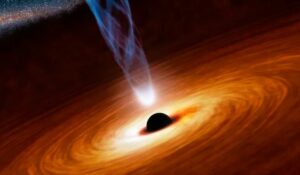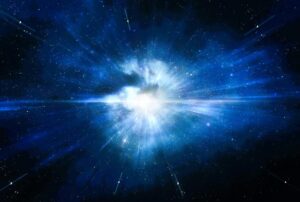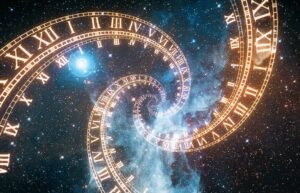- abaashishb7
- April 23, 2024
- 10:49 am
- No Comments
Space Hole
* Navigating the Enigmatic Realm of Space Holes: Lost in Space
In the boundless expanse of the cosmos, amidst the twinkling stars and swirling
galaxies, lie mysterious phenomena that defy conventional understanding—space
holes. These cosmic enigmas, also known as wormholes or black holes, beckon us into
their depths with the allure of the unknown. In this article, we embark on a journey to
explore the captivating realm of space holes, delving into their nature, properties, and
the profound implications they hold for our understanding of the universe.
* Unveiling the Mystery
Space holes, whether in the form of wormholes or black holes, are gravitational
anomalies that warp the fabric of spacetime itself. They are characterized by their
immense gravitational pull, so strong that even light cannot escape their grasp. The
concept of space holes emerged from the equations of general relativity, proposed by
Albert Einstein, and has since captured the imagination of scientists and science fiction
enthusiasts alike.
1:- Defining Space Holes: Emptiness in the Cosmos
At the heart of our inquiry lies the concept of space holes, also known as cosmic voids
or supervoids. These vast expanses of cosmic emptiness span hundreds of millions of
light-years across, manifesting as seemingly barren regions amidst the bustling cosmic
web of galaxies and clusters. Unlike the densely populated galactic neighborhoods
that punctuate the universe, space holes are characterized by their striking scarcity
of cosmic matter, presenting a stark departure from our traditional understanding of
cosmic structure.
2:- Unraveling the Origins of Cosmic Vacuums
The genesis of space holes stands as a conundrum that continues to elude definitive
explanations, fueling ongoing research and theoretical speculation. Among the
prevailing hypotheses, one posits that the gravitational interplay between the
surrounding matter may have catalyzed the formation of these voids, triggering the
expansion of regions with lower cosmic density over cosmic time scales. Alternatively,
proponents of another theory suggests that the primordial fluctuations of density in the
early universe may have seeded the emergence of space holes as the cosmos
underwent its evolutionary journey.
3:- Peering into the Abyss: Navigating the Cosmic Void
Venturing into the depths of space holes presents a unique odyssey fraught with
challenges and opportunities for scientific exploration. Unlike the bustling galactic
metropolises that adorn the cosmic landscape, space holes offer astronomers a rare
glimpse into the intricacies of cosmic emptiness. Armed with cutting-edge telescopes
and innovative observational techniques, researchers endeavor to unravel the
mysteries concealed within these voids, probing the underlying mechanisms that
govern their formation and evolution.
* Types of Space Holes
1:- Wormholes: These theoretical tunnels in spacetime serve as cosmic gateways,
connecting disparate points in the vast expanse of the universe. Imagine them as
cosmic shortcuts, allowing for instantaneous travel between distant celestial bodies.
While the existence of traversable wormholes remains purely speculative, their
theoretical framework tantalizes scientists and space enthusiasts alike with the
possibility of transcending the limitations of conventional space-time. If these
hypothetical passages were to exist, they would revolutionize our understanding of
interstellar travel, offering a means to traverse vast cosmic distances in the blink of an
eye.
2:- Black Holes: Among the most enigmatic entities in the cosmos, black holes are
celestial phenomena born from the catastrophic collapse of massive stars. Within the
confines of a black hole’s event horizon, gravity reigns supreme, distorting spacetime
to such an extent that not even light can escape its grasp. The gravitational pull of a
black hole is so intense that it forms a singularity—a point of infinite density—at its
core, where the laws of physics as we know them to break down. These cosmic
behemoths serve as cosmic vacuum cleaners, swallowing everything that ventures too
close, including stars, planets, and even light itself. The formation of black holes
represents a cosmic ballet of stellar death, where massive stars, having exhausted their
nuclear fuel, collapse under their own gravity, leaving behind a gravitational abyss from
which nothing can escape.
* Origins and Formation
1:- Pondering Origins: A Conundrum in Cosmic Evolution
The genesis of space holes stands as a tantalizing enigma that continues to elude
definitive explanation, captivating the minds of astronomers and cosmologists alike.
Amidst ongoing research and spirited debate, several theories have emerged, each
offering a unique perspective on the formation of these cosmic voids. Among the
prevailing hypotheses, two prominent theories vie for supremacy, each seeking to
unravel the mysteries shrouding the origins of space holes.
2:- Gravitational Dynamics: A Catalyst for Cosmic Voids
One prevailing theory posits that the formation of space holes is intricately linked to the
gravitational dynamics of the universe. According to this hypothesis, the gravitational
pull exerted by surrounding matter plays a pivotal role in sculpting the cosmic
landscape, giving rise to regions of low density that gradually expand over cosmic time
scales. As galaxies and cosmic structures gravitate towards denser regions, regions of
lower density are left behind, eventually coalescing into the vast expanses of
emptiness observed in space holes.
3:- Primordial Fluctuations: Seeds of Cosmic Emptiness
An alternative hypothesis proposes that the origins of space holes trace back to the
primordial fluctuations in density that permeated the early universe. During the
formative stages of cosmic evolution, minuscule variations in density gave rise to
regions of higher and lower cosmic density, laying the groundwork for the emergence
of cosmic voids. As the universe expanded and evolved, these primordial fluctuations
persisted, eventually culminating in the formation of space holes as the cosmic
tapestry unfolded.
4:- Navigating the Cosmic Epochs: Tracing the Evolution of Space Holes
Regardless of their origins, space holes offer a tantalizing window into the dynamic
evolution of the universe over cosmic time scales. By studying the distribution and
properties of these cosmic voids, astronomers gain invaluable insights into the
underlying mechanisms that have shaped the cosmic landscape. Whether through
gravitational dynamics or primordial fluctuations, the formation of space holes
represents a testament to the intricate interplay of cosmic forces that have sculpted
the universe since its inception.
* The Science Behind the Phenomenon
Space holes, whether in the form of wormholes or black holes, wield a profound
influence on their cosmic surroundings, reshaping the fabric of spacetime itself. Their
gravitational prowess manifests in awe-inspiring phenomena that challenge our
understanding of the universe.
Gravitational Lensing: One of the most striking effects of space holes is
gravitational lensing, a phenomenon where the immense gravitational field of a black
hole bends the path of light, distorting the images of objects located behind it. This
cosmic distortion creates mesmerizing visual phenomena, such as Einstein’s rings and
gravitational mirages, offering astronomers valuable insights into the distribution of
mass in the universe.
Time Dilation and Event Horizon
1:- Time Dilation: Perhaps the most captivating aspect of space holes is their ability to
warp the flow of time itself. According to Einstein’s theory of relativity, time near a black
hole progresses at a different rate compared to regions of lesser gravitational
influence. This phenomenon, known as time dilation, results in a relative slowing of
time near the intense gravitational field of a black hole. As a result, an observer near
the black hole would perceive time passing more slowly compared to someone in a less
gravitationally intense environment. Time dilation challenges our fundamental
understanding of the nature of time and space, inviting us to contemplate the
intricacies of the cosmos.
2:- Event Horizon: The event horizon, a defining feature of black holes, marks the
boundary beyond which escape from the gravitational clutches of the black hole
becomes impossible. Once an object crosses this threshold, it is inexorably drawn
towards the singularity at the heart of the black hole, never to return. The event horizon
represents a cosmic point of no return, where the laws of physics as we know them
cease to apply. It is a realm where space and time intertwine in an intricate dance,
leading the observer into the abyss of the unknown.
The science behind space holes unveils a cosmic tapestry of gravitational phenomena
that captivate the imagination and inspire scientific inquiry. From gravitational lensing
to time dilation and the enigmatic event horizon, space holes continue to push the
boundaries of our understanding of the universe, inviting us to explore the mysteries
that lie beyond the confines of our comprehension.
* Implications and Speculations
1:- Interstellar Travel: The existence of wormholes presents a tantalizing avenue for
interstellar exploration, offering the potential to traverse vast cosmic distances in a
fraction of the time required by conventional propulsion methods. If traversable
wormholes were to be discovered or engineered, they could serve as cosmic shortcuts,
revolutionizing our approach to space travel and opening up new frontiers for human
exploration beyond the confines of our solar system. The prospect of interstellar travel
raises questions about the feasibility of colonizing distant exoplanets and the potential
for humanity to become an interstellar species, venturing forth into the cosmos in
search of new horizons and extraterrestrial life.
2:- Time Travel: While the practicality of time travel remains a subject of debate, the
theoretical framework provided by space holes offers tantalizing glimpses into the
possibility of journeying through the annals of time. According to Einstein’s theory of
relativity, the extreme gravitational effects near black holes can warp the fabric of
spacetime to such an extent that time itself becomes distorted. This phenomenon,
known as time dilation, raises intriguing possibilities for exploring the past, present,
and future of the universe. While the practical challenges of time travel—such as
avoiding paradoxes and maintaining causality—remain formidable, the theoretical
groundwork laid by space holes invites us to contemplate the mysteries of time and the
nature of reality.
The implications and speculations surrounding space holes represent a frontier of
scientific inquiry and imagination, offering tantalizing prospects for the future of
humanity’s exploration of the cosmos. From the possibility of interstellar travel to the
tantalizing prospect of time travel, space holes continue to inspire awe and wonder,
challenging us to push the boundaries of our understanding of the universe and our
place within it.
* Navigating the Cosmic Void
1:- Embracing the Challenge: Exploring the Uncharted Territories
Traversing the expansive reaches of space holes presents a journey unlike any other—a
voyage through the vast expanse of cosmic emptiness that defies conventional
understanding. Unlike the bustling galactic neighborhoods found in densely populated
regions of the universe, space holes offer astronomers a unique opportunity to probe
the subtle interplay between cosmic voids and the surrounding cosmic web. Amidst the
emptiness that pervades these voids lies a wealth of untapped potential for scientific
exploration and discovery.
2:- Unlocking the Secrets: Probing the Depths of Cosmic Emptiness
Armed with advanced telescopes and innovative observational techniques,
astronomers embark on a quest to unravel the mysteries concealed within the depths
of space holes. By peering into these cosmic voids with unparalleled precision,
researchers gain invaluable insights into the distribution of matter in the universe and
the underlying processes that govern its evolution. Each observation offers a
tantalizing glimpse into the intricate tapestry of cosmic structure, shedding light on the
fundamental principles that shape the cosmos.
3:- A Canvas for Discovery: Studying the Cosmic Web
Within the vast expanse of space holes, astronomers find themselves amidst a cosmic
tableau ripe with opportunities for exploration. By studying the interplay between voids
and the surrounding cosmic web, researchers unveil the complex dynamics that govern
the evolution of the universe. From the clustering of galaxies to the formation of
cosmic filaments, each observation provides a piece of the puzzle, allowing
astronomers to piece together the intricate tapestry of cosmic structure.
4:- The Promise of Insight: Advancing Our Understanding of the Cosmos
As astronomers delve deeper into the cosmic void, they unlock a treasure trove of
knowledge that reshapes our understanding of the universe. By probing the depths of
space holes, researchers gain invaluable insights into the distribution of matter, the
dynamics of cosmic evolution, and the fundamental principles that govern the cosmos.
Each observation serves as a stepping stone toward a deeper comprehension of
the universe and our place within it, illuminating the path toward new discoveries and
revelations.
The enigmatic realm of space holes represents one of the most fascinating frontiers in
modern astrophysics. From their mysterious properties to their profound implications
for the nature of spacetime and gravity, space holes continue to captivate the
imagination and inspire scientific inquiry. As we continue to unravel the mysteries of
the cosmos, the exploration of space holes promises to shed light on some of the
deepest questions about the nature of the universe and our place within it.
- abaashishb7
- April 23, 2024
- 10:49 am
- No Comments



